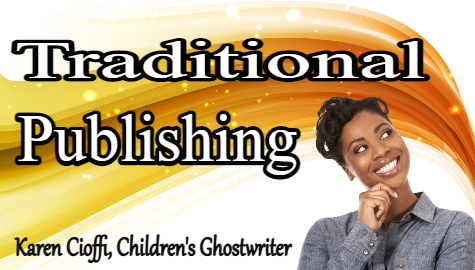While most of my children’s ghostwriting clients go the self-publishing route, about a quarter of them (maybe a little less) take on traditional publishing.
Why go traditional? What’s the draw?
1. The first reason is the budget.
When dealing with children’s books, many authors don’t have the budget to hire an illustrator.
For a standard picture book, there are usually 12-14 interior illustrations. That’s the bare minimum. If the author wants an illustration on every page, then it’s double the amount.
If the author has a chapter book, then she’s looking at illustration for each chapter, at the very least. Thinking on the low end, if the author has 5,000 words, that should be divided into around ten chapters of about 500 words each. So that’s ten interior illustrations.
Even middle-grade books can use interior illustrations here and there, possibly for each chapter.
Granted, you can have different types of interior illustrations, such as half-pages and sketches, but it’s still an expense.
Then there are the front and back covers.
Using the illustrators I work with, the pricing ranges from $80 to $200 per interior illustration and $200+ for the front cover. Pricing is usually less for the back cover. And these illustrators are very reasonable.
I’ve had clients who have paid $10,000 or more for illustrations.
So, it’s easy to see that having to pay for illustrations can get expensive.
On the flip side, the children’s author doesn’t need to pay for illustrations with traditional publishing. The publishing house uses its own illustrators and covers the expense.
This is a huge deal and is a major draw of traditional publishing.
2. The second draw is the prestige and validation associated with traditional publishing.
While I’m self-published and traditionally published, let’s face it, they still don’t hold the same weight. That’s just the way it is.
The primary reason for this is that many self-published books lack professional quality.
With the ease of self-publishing, anyone can slap a book together without knowing how to write and put it up for sale.
These authors make it difficult for authors who take the time to learn the craft of writing and create a professional book.
Although the old stigma associated with self-publishing is beginning to ease.
3. The third draw is it’s all done for you.
Most authors, especially the newbies, don’t know how to go about self-publishing. Having a publishing company handle everything for no cost to you is extremely alluring.
Just keep in mind the legwork and patience involved to get a traditional contract:
A. The author needs to create a query and synopsis of the book
B. The author needs to research publishers and agents that deal with the particular genre
C. The author needs to submit the manuscript
D. The author needs to wait for a bite, which is not guaranteed
E. An accepted manuscript can take 18-24 months before it’s actually published.
But aside from the work and time involved, if the author gets a book contract, she has a professional group behind her. She can rest assured she’ll have a professional book.
So, these are the top three reasons why some children’s authors prefer going the traditional path.
I’m a working children’s ghostwriter, rewriter, and coach. I can help turn your story into a book you’ll be proud to be the author of, one that’s publishable and marketable.
OTHER HELP I OFFER:
HOW TO WRITE A CHILDREN’S FICTION BOOK
A DIY book to help you write your own children’s book.
FICTION WRITING FOR CHILDREN eCOURSE
4-Weeks / 8 Sections Guided Self-Study Program
You can contact me at kcioffiventrice@gmail.com.

What’s Stopping You from Becoming a Children’s Author
Submitting to an Editor or Literary Agents? 6 Things to Watch For



2 thoughts on “Top 3 Draws of Traditionally Publishing Children’s Books”